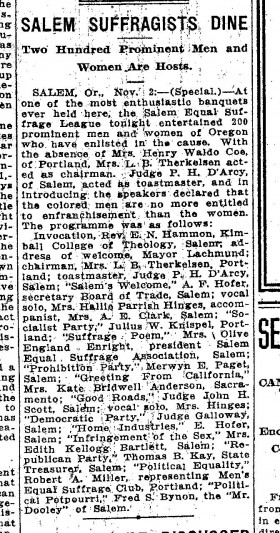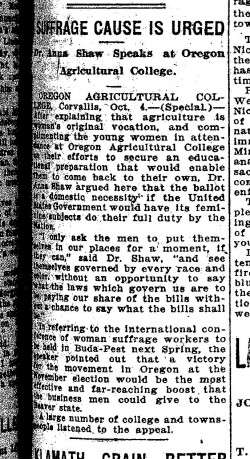January 4, 1912 Men’s Equal Suffrage League
“Men Lend Aid in Great Battle for Woman Suffrage,” Oregon Journal, January 4, 1912, 10.
Many Oregon men supported votes for women in the final and successful 1912 campaign. On January 3, 1912, dozens of men gathered at the Commercial Club in Portland to form what would become the Men’s Equal Suffrage League of Multnomah County, chaired by attorney William M. “Pike” Davis. Abigail Scott Duniway served as acting chair for the evening. Politicians, judges, attorneys and labor leaders spoke in favor of suffrage.
Some had “long favored” votes for women, including former state legislator C.W. Fulton who introduced an amendment to the Oregon constitution providing for woman suffrage in 1883. Among the more “recent converts” was attorney and state senator Dan J. Malarky who said that “the light had been breaking in on him for a long time but he was converted last year.” Labor leaders in support of suffrage included Floyd Ramp of the Socialist Party of Oregon and Eugene Smith, vice president of the Electrical Workers’ Union.
Oregon men joined men in other states who had organized to support votes for women. Their support was a significant element of the victory in Oregon in 1912.
—Kimberly Jensen

Further reading:
Kimberly Jensen, “‘Neither Head nor Tail to the Campaign’: Esther Pohl Lovejoy and the Oregon Woman Suffrage Victory of 1912,” Oregon Historical Quarterly 108:3 (Fall 2007): 350-383.
Want to read more articles from Oregon suffrage campaigns? Click here
Permalink
December 1912 First Woman Votes in Umatilla
“First Woman to Vote in Umatilla City, OR.,” Oregon Journal, December 5, 1912, 10.
Many cities in Oregon held elections in December 1912, just weeks after women in the stated gained the right to vote in November that year. Across the state women cast their ballots and fulfilled the other duties of voting citizens including service as election judges. In Umatilla Mrs. H. T. Duncan was the first woman to vote in her city election and she served as an election judge that day, no doubt an important fulfillment of her goals as a suffrage supporter. Duncan, in business in Umatilla for twenty years, operated the Duncan Hotel.
—Kimberly Jensen

Further reading:
Kristi Andersen, After Suffrage: Women in Partisan and Electoral Politics before the New Deal (Chicago: The University of Chicago Press, 1996)
Sophonisba P. Breckinridge, Women in the Twentieth Century: A Study of Their Political, Social, and Economic Activities (New York: McGraw Hill, 1933), 245-56.
Want to read more articles from Oregon suffrage campaigns? Click here
Permalink
November 3, 1912 Salem Suffragists Gather
“Salem Suffragists Dine,” Oregonian, November 3, 1912, 9.
In communities across Oregon suffragists prepared final meetings before the November 1912 election, including a large group in Salem.
As suffragists and their supporters prepared for the November 1912 election they held final meetings to draw attention to the woman suffrage measure on the ballot. This article demonstrates the variety of suffrage supporters and the reach of suffrage ideas in Salem and the state.
—Kimberly Jensen

Want to read more articles from Oregon suffrage campaigns? Click here
Permalink
Anna Howard Shaw at Oregon Agricultural College in Corvallis, October 4, 1912
“Suffrage Cause is Urged: Dr. Anna Shaw Speaks at Oregon Agricultural College,” Oregonian October 5, 1912, 5.
October 4, 1912 Corvallis greets NAWSA President Anna Howard Shaw.
On her tour through Oregon in September and October during the final push of the 1912 campaign for woman suffrage, Anna Howard Shaw, president of the National American Woman Suffrage Association (NAWSA), visited Corvallis and spoke at the Oregon Agricultural College (now Oregon State University).
Shaw told the women students in the audience that “agriculture is woman’s original vocation” and praised them for “their efforts to secure an educational preparation that would enable them to come back to their own.” The suffrage movement was popular on college campuses in Oregon and around the state. Andrea Moss-Radke has studied the Oregon Agricultural College experience with woman suffrage in connection with other land grant colleges in the western United States.
Shaw also exhibited a view of race and ethnicity that pitted white women who did not have the vote against men “of every race and color” who did. Such arguments were part of what Louise Newman calls the movement for “white women’s rights” that has divided reform movements in Oregon and the nation. In Oregon, activists such as Hattie Redmond of the Colored Women’s Equal Suffrage League of Portland worked to make a movement that would address the rights of all women.
—Kimberly Jensen

Further Reading:
Andrea Radke-Moss, Bright Epoch: Women and Coeducation in the American West (Lincoln: University of Nebraska Press, 2008)
Louise Michelle Newman, White Women’s Rights: The Racial Origins of Feminism in the United States (New York: Oxford University Press, 1999)
Want to read more articles from Oregon suffrage campaigns? Click here
Permalink
Rogue Valley Suffragists in the “Made in Medford” parade September 19, 1912.
Supporters of votes for women in the Rogue River Valley decorated cars and rode horses in the “Made in Medford” parade September 19, 1912.
“100 Suffragists in Line,” Oregonian, September 20, 1912, 16.
September 19, 1912 Jackson County Suffragists Campaign in the “Made in Medford” Parade
In the final Oregon woman suffrage campaign in 1912 activists in communities across the state used county fairs as a way to publicize their views and reach male voters. At the Jackson County Fair one hundred women decorated cars and rode horses as a “special attraction” in the “Made in Medford” parade. Gladys Heard, secretary of the Medford Equal Suffrage Association, rode in the lead car festooned with sunflowers and filled with children. Other cars sported “Votes for Women” flags and streamers. Across this 1912 campaign suffragists took their cause to the people and used popular culture and mass media to make their argument.
Opponents of woman suffrage asserted that the vote would take women away from traditional home duties. Medford suffragists created a float to make fun of this argument. “Prominent Medford men” E.E. Kelly, C. L. Schlefflin and Holbrook Withington dressed as women and as the float passed through the streets they washed clothes and nursed a “huge rag doll” with a whiskey bottle. Suffragists may also have included the children of supporters in the lead car to emphasize that the vote would enhance women’s roles as mothers, not detract from them.
—Kimberly Jensen

Further reading:
Margaret Finnegan, Selling Suffrage: Consumer Culture and Votes for Women (New York: Columbia University Press, 1999)
Susan E. Marshall, Splintered Sisterhood: Gender and Class in the Campaign against Woman Suffrage (Madison: University of Wisconsin Press, 1997)
Want to read more articles from Oregon suffrage campaigns? Click here
Permalink

